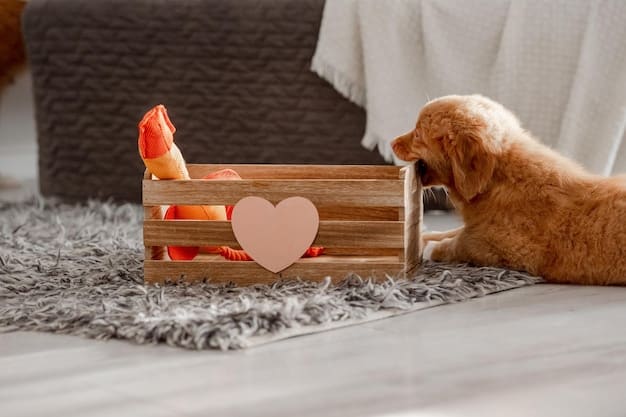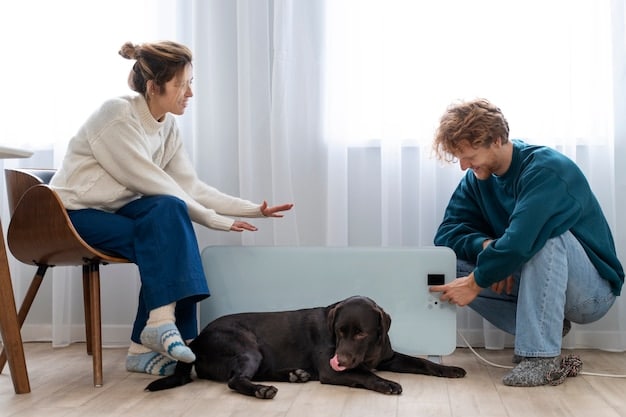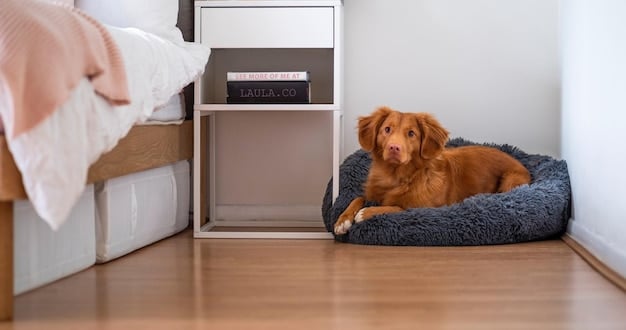Overcome Crate Training Resistance: A 5-Day Guide to a Happy Crate

Anúncios
Crate training resistance can be frustrating, but turning your dog’s crate into a haven is achievable in just five days with positive reinforcement and consistent routines, creating a comfortable and safe space for your furry friend.
Is your dog resisting crate training? **Crate training resistance: turn your dog’s crate into a happy place in 5 days** with these simple, effective techniques. Let’s transform that den into a cozy retreat!
Anúncios
Understanding Crate Training Resistance
Before diving into the five-day plan, it’s crucial to understand why your dog might be resisting the crate. Is it fear, anxiety, or simply a lack of positive association?
Anúncios
Understanding the root cause of your dog’s aversion is paramount. This could stem from various factors, including past negative experiences, separation anxiety, or unfamiliarity with the crate environment.
Common Reasons for Crate Training Resistance
Many dogs develop crate training resistance due to negative experiences or associations. Recognizing these reasons can help you tailor your approach to crate training.
- Past Trauma: A previous stay at a vet or boarding facility could trigger negative associations with confinement.
- Lack of Familiarity: A sudden introduction to the crate without proper acclimatization can cause anxiety.
- Separation Anxiety: Some dogs associate the crate with being left alone, leading to distress.
- Negative Reinforcement: Forcing a dog into the crate or using it as punishment can create fear.
Identifying these causes allows you to implement a strategy that addresses your dog’s specific concerns. This often involves creating positive experiences around the crate.
Day 1: Introduction and Positive Association
The first day is all about introducing your dog to the crate in a positive, non-threatening way. Make it inviting and comfortable without forcing your dog inside.
On day one, focus on making the crate a welcoming space. This involves creating positive experiences around it without any pressure to enter. The goal is to associate the crate with pleasant things.
Making the Crate Inviting
- Placement: Put the crate in a central location where your dog spends most of their time. This helps them feel included and less isolated.
- Comfort: Make the crate comfortable with soft bedding, toys, and maybe even an old t-shirt with your scent on it.
- Open Door Policy: Leave the crate door open and let your dog explore it on their own terms.
Positive Reinforcement near the Crate
Use high-value treats and praise to reward your dog for simply being near the crate. This helps them form a positive association without any pressure to enter.
- Treat Toss: Toss treats near the crate, gradually moving them closer to the entrance.
- Verbal Praise: Use a cheerful and encouraging tone of voice to praise your dog for interacting with the crate.
- No Coercion: Never force your dog into the crate. This can create negative associations.

By the end of day one, your dog should view the crate as a safe and potentially rewarding place without any pressure or fear.
Day 2: Crate Exploration and Feeding
Encourage your dog to enter the crate voluntarily. Start feeding meals inside to create a positive association with being inside the crate.
Day two builds upon the positive associations from day one, encouraging your dog to enter the crate willingly. Feeding meals inside helps to strengthen these positive feelings.
Luring Your Dog Inside
Use a treat or toy to lure your dog into the crate. Toss it inside and let them follow. As they enter, offer praise and another treat.
- Gradual Approach: Don’t push your dog if they’re hesitant. Start by just getting them to put their head inside.
- Positive Reinforcement: Reward every step of progress with praise and treats.
- Short Sessions: Keep sessions short and positive, ending on a good note.
Feeding Meals in the Crate
Once your dog is comfortable entering the crate, start feeding their meals inside. This creates a strong positive association with being in the crate.
- Bowl Placement: Place the food bowl at the back of the crate, encouraging your dog to go all the way inside.
- Door Open: Keep the crate door open during meals to avoid any feelings of confinement.
- Positive Reinforcement: Praise your dog while they’re eating in the crate.
By the end of day two, your dog should be comfortable entering the crate to eat, further solidifying the positive association.
Day 3: Short Crate Stays
Start closing the crate door for very short periods while your dog is inside, gradually increasing the duration. Monitor your dog for signs of distress.
Day three involves introducing short crate stays with the door closed. The goal is to gradually increase the duration, ensuring your dog remains comfortable and calm.
Closing the Door Briefly
Once your dog is eating comfortably in the crate, start closing the door briefly while they’re eating. Open it immediately after they finish to avoid any anxiety.
- Supervision: Always supervise your dog during these initial crate stay sessions.
- Positive Reinforcement: Offer praise and a treat when you open the door.
- Gradual Increase: Slowly increase the duration of the crate stay in small increments.
Monitoring for Distress
Watch your dog closely for signs of distress, such as excessive whining, barking, or panting. If they show signs of anxiety, shorten the crate stay.
- Body Language: Pay attention to your dog’s body language. A relaxed posture indicates comfort.
- Vocalization: Occasional whimpering is normal, but excessive vocalization signals distress.
- Breathing: Rapid or heavy breathing can be a sign of anxiety.
By the end of day three, your dog should be able to tolerate short crate stays without significant distress, laying the foundation for longer periods.

Day 4: Extending Crate Time
Gradually increase the amount of time your dog spends in the crate with the door closed. Introduce interactive toys to keep them entertained.
On day four, the focus is on extending the crate time while ensuring your dog remains engaged and comfortable. Interactive toys play a crucial role in keeping them entertained during these longer periods.
Increasing Duration
Gradually increase the amount of time your dog spends in the crate, adding a few minutes each session. Continue to monitor for signs of distress.
- Consistent Schedule: Establish a consistent crate schedule to help your dog adjust.
- Predictability: Make crate time predictable by associating it with specific activities, such as feeding or playtime.
- Positive Reinforcement: Provide praise and a small treat each time you let your dog out of the crate.
Interactive Toys
Provide your dog with interactive toys, such as puzzle toys or chew toys, to keep them entertained while in the crate. This helps to prevent boredom and anxiety.
- Puzzle Toys: These toys challenge your dog mentally and provide a sense of accomplishment.
- Chew Toys: Durable chew toys can help relieve anxiety and prevent destructive chewing.
- Rotation: Rotate toys regularly to keep your dog interested and engaged.
By the end of day four, your dog should be able to spend longer periods in the crate without significant distress, thanks to the structured routine and engaging toys.
Day 5: Real-World Scenarios and Maintenance
Simulate real-world scenarios, such as leaving the house for short periods. Continue to reinforce positive crate associations with treats and praise. Maintenance is key.
Day five involves simulating real-world scenarios to prepare your dog for normal crate use, such as being left alone. Consistent maintenance is crucial to reinforcing positive associations.
Simulating Departures
Practice leaving the house for short periods, gradually increasing the duration. This helps your dog adjust to being alone in the crate.
- Short Trips: Start with very brief departures, such as going to the mailbox or taking out the trash.
- Quiet Departures: Avoid making a fuss when you leave. Simply say a calm goodbye.
- Gradual Increase: Gradually increase the duration of your trips to help your dog adjust.
Maintenance and Consistency
Continue to reinforce positive crate associations with treats and praise. Consistency is key to maintaining your dog’s comfort and cooperation.
- Regular Crate Time: Continue to incorporate crate time into your dog’s daily routine.
- Positive Reinforcement: Regularly provide treats and praise, even when your dog is already comfortable.
- Avoid Punishment: Never use the crate as punishment. This can create negative associations and undermine your progress.
By the end of day five, your dog should be well on their way to accepting the crate as a safe and comfortable space. Regular maintenance ensures these positive associations endure.
| Key Point | Brief Description |
|---|---|
| 🏠 Positive Association | Link the crate with treats and comfort. |
| ⏰ Gradual Increase | Slowly extend crate stay durations. |
| 🧸 Interactive Toys | Keep your dog entertained in the crate. |
| 🚶 Simulate Departures | Practice leaving for short periods. |
Frequently Asked Questions
▼
Don’t force it. Lure them with treats or toys. Make the crate a fun, inviting space. Patience is key to overcoming initial hesitations.
▼
No. Crates should not be used for extended periods. Dogs need exercise, socialization, and potty breaks. Aim for shorter periods, especially during training.
▼
Ensure all needs are met: potty, food, water. Ignore attention-seeking whining. Reward quiet behavior. Make sure the crate is comfortable and not isolating.
▼
Never use the crate as punishment. It should be a safe, positive space. Punishment can create negative associations and increase anxiety, setting back your progress.
▼
Ensure they have appropriate chew toys. Supervise crate time initially. Reduce crate time if destruction persists. Consult a trainer if the behavior continues.
Conclusion
Overcoming crate training resistance in your dog is a journey that requires patience, consistency, and a focus on positive reinforcement. By following this five-day plan, you can transform your dog’s crate into a happy and secure place, fostering a stronger bond and a more relaxed pet.






